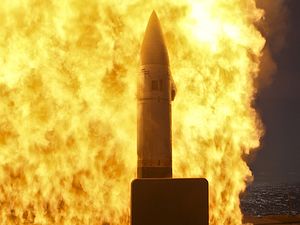On July 19, the U.S. State Department cleared the possible sale of 246 Raytheon SM-2 Block IIIB standard missiles, equipment, and support to Japan at an estimated cost of $821 million, according to a press release by the U.S. Defense Security Cooperation Agency (DSCA), the Pentagon’s lead agency responsible for arms sales to allies and partner nations. The arms deal is still subject to congressional approval before it can proceed.
“The Government of Japan has requested a possible sale of up to two hundred forty-six (246) Standard Missile (SM-2), Block IIIB Vertical Launching Tactical All-Up Rounds, RIM-66M-09. This request also includes MK 13 MOD 0 Vertical Launching System Canisters, operator manuals and technical documentation, U.S. Government and contractor engineering, technical and logistics support services,” the press release notes.
M-2 Block IIIB standard missiles are advanced surface-to-air missiles capable of intercepting targets at a distance of up to 90 nautical miles (166 kilometers) and an altitude of 65,000 (19,812 meters). According to the missile’s manufacturer, U.S. defense contractor Raytheon, it is “lethal against subsonic, supersonic, low- and high- altitude, high-maneuvering, diving, sea-skimming, anti-ship cruise missiles fighters, bombers, and helicopters in an advanced electronic countermeasures environment.”
According to the press release, the possible arms sale “is consistent with U.S. foreign policy and national security objectives and the 1960 Treaty of Mutual Cooperation and Security.” The new missiles will be deployed aboard a number of destroyers of the Japan Maritime Self-Defense Force (JMSDF):
These SM-2 Block IIIB missiles will be used for anti-air warfare at sea. Japan currently fields four Kongo-class and two Atago-class destroyers, all of which are equipped with the Aegis Combat system and SM-2 Block IIIA/IIIB missiles. Japan is also building two new Aegis-equipped destroyers based on a modified Atago-class hull. The SM-2 Block IIIB missiles proposed in this sale will be used on these two future destroyers as well as supplementing Japan’s missile inventory.
Atago-class vessels are an improved version of the Kongo-class of guided missile destroyers. Next to the Atago and Kongo ship classes, Akizuki-class general purpose destroyers are also currently equipped with the Aegis combat system. Japan is already operating two maintenance facilities capable of maintaining the new missiles.
The United States and Japan have also been jointly developing Raytheon’s next-generation Standard Missile-3 (SM-3) Block IIA. “In detail, the SM-3 Block IIA is designed to destroy short- to intermediate-range ballistic missile threats in space and can be deployed at land-based Aegis Ashore sites,” as I explained elsewhere.

































